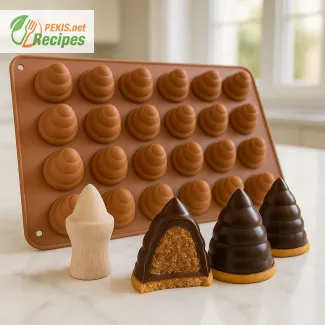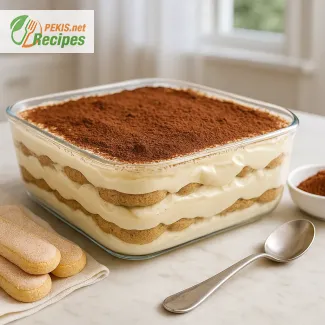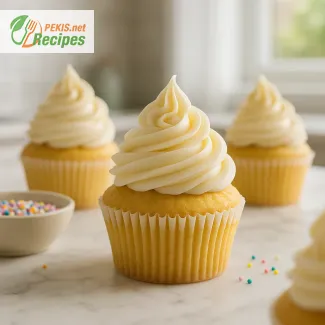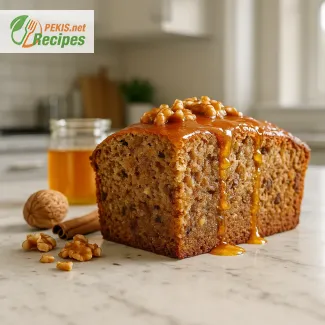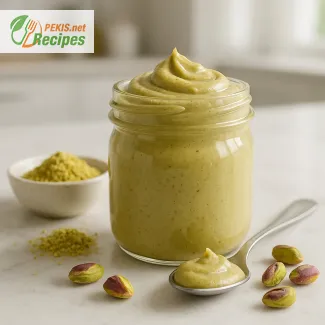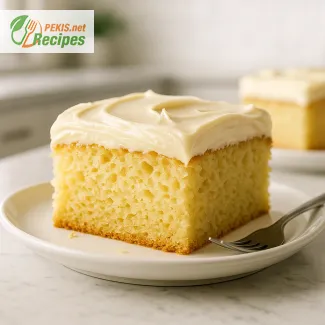Rich, velvety, and fragrant, Sister Vendeline’s poppy seed filling yields enough for 8 portions, with 20 minutes prep, 25 minutes cooking, and a total of 45 minutes. Made from ground poppy seeds, milk, butter, sugar, and honey, it develops a smooth, glossy texture ideal for strudels, rolls, and cakes. The mixture balances nutty sweetness with lemon zest and vanilla, offering a deep, aromatic flavor that elevates any pastry. It stays perfectly fresh for 5 days refrigerated or can be frozen for up to 3 months, retaining its creamy consistency when gently reheated.
Years of working with traditional European pastries have shown how much texture and aroma matter when crafting the perfect poppy seed filling. There’s a special kind of patience involved — slowly cooking the seeds, watching them release their natural oils, and blending them into a silky, fragrant mixture that carries both warmth and nostalgia. Every small adjustment, from the balance of lemon zest to the smoothness of melted butter, transforms the outcome completely. What truly makes this recipe stand out is how it captures that authentic old-world taste in a form that’s still simple to prepare in any modern kitchen.
PEKIS – professional chef and recipe developer with over 25 years of experience in cooking and baking, specialized in European and international cuisine.
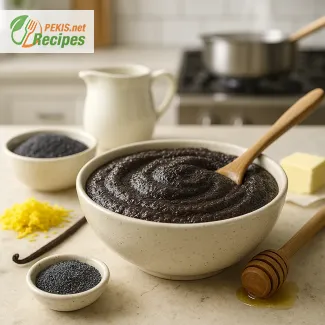
The Timeless Charm of Poppy Seed Filling Inspired by Sister Vendeline
A velvety-smooth, aromatic poppy seed blend cherished across Central Europe
The scent of warm poppy seeds gently simmering in milk evokes a nostalgic sense of home, tradition, and celebration. This poppy seed filling, inspired by the meticulous baking of Sister Vendeline’s bakery, carries with it the unmistakable charm of old-world craftsmanship. Deeply rooted in Central European pastry culture, this luscious, slightly nutty mixture transforms simple dough into a masterpiece of texture and aroma. From golden holiday rolls to delicate strudels and festive cakes, its deep black color and subtle sweetness speak of time-honored traditions passed down through generations of bakers.
Long before industrial fillings or quick shortcuts, poppy seed paste was a symbol of patience and care. In convent kitchens and family bakeries, every batch began with freshly ground seeds, slowly cooked to release their buttery richness and gentle earthiness. The key lies in the perfect balance between creamy texture and just the right sweetness — a fine art that Sister Vendeline mastered through decades of practice. Her recipe reflects a precise ratio of poppy seeds, milk, sugar, and a touch of honey, blended until the filling becomes glossy and aromatic, ready to enrich pastries with its soft, fragrant core.
Unlike nut fillings, poppy seed filling has a uniquely silky mouthfeel and subtle bittersweet undertone that pairs beautifully with buttery doughs. The gentle sweetness allows it to complement rich yeasted pastries, while hints of lemon zest, vanilla, or rum elevate its complexity. Some regional versions include a touch of semolina or breadcrumbs for thickness, while others prefer a smoother, cream-like texture. Each variation tells a story — of families gathering, of holidays celebrated, and of bakers pouring their hearts into their craft.
The heritage behind Sister Vendeline’s recipe
Sister Vendeline’s story begins in a small monastic kitchen where baking was both a devotion and an art. Her poppy seed filling became legendary among locals, not just for its flavor but for the way it made each pastry taste like comfort and care. It was often used for festive rolls, strudels, and kolaches, especially around Christmas and Easter — seasons of warmth, reflection, and sharing. Today, her version remains a favorite among bakers who seek authenticity, preferring slow-cooked ingredients and the natural oils of poppy seeds to create that signature depth of flavor.
Over time, her method spread through local communities, inspiring bakers to add their own touches — a drop of almond extract, a drizzle of honey, or even a handful of raisins soaked in rum. What makes it timeless is not just its taste but its adaptability — a foundation for countless desserts, from traditional potica to modern tarts and croissants.
Why you’ll love this filling
- Velvety texture that melts into doughs and pastries effortlessly.
- Rich nutty aroma that enhances both sweet and yeasted pastries.
- Naturally satisfying flavor without the need for excessive sugar.
- Versatile — perfect for rolls, strudels, cakes, and festive breads.
- Rooted in tradition, offering a taste of true Central European baking heritage.
Key elements and flavor profile
A perfect poppy seed filling depends on texture and aroma. Finely ground poppy seeds are essential; they release natural oils when gently heated with milk or cream, creating a luscious base. Sugar or honey provides sweetness, while butter or cream lends depth. A hint of vanilla, citrus peel, or cinnamon brightens the blend, preventing heaviness. The resulting paste should be moist but not runny, sweet but not cloying, and deeply fragrant with natural oils.
When made correctly, the filling spreads smoothly, clings softly to pastry layers, and bakes to a gentle sheen. The result is a flavor that’s both rustic and elegant — rich enough for celebration yet simple enough for everyday indulgence.
Creative variations
- Add ground almonds or walnuts for extra richness.
- Infuse with orange zest or rum for a festive twist.
- Blend in honey and raisins for a moist, aromatic version.
- Mix with a spoonful of semolina to thicken without losing creaminess.
- Create a chocolate-poppy version by melting dark chocolate into the warm mixture.
Storage and make-ahead preparation
This filling keeps remarkably well. Once cooled, it can be stored in an airtight container in the refrigerator for up to 5 days, maintaining its smoothness and aroma. For longer storage, it freezes beautifully — simply thaw slowly in the fridge and stir before using. To restore its silky texture, warm gently with a spoon of milk before spreading over dough.
Culinary context and serving inspiration
In Central European cuisine, poppy seeds symbolize prosperity and abundance. Their presence in baked goods during holidays was believed to bring luck for the coming year. Whether used in potica, makowiec, beigli, or strudel, this filling connects cultures through shared flavors and memories. In modern kitchens, it has found its place in croissant-style pastries, babkas, and layered cakes, appreciated by pastry chefs and home bakers alike.
A spoonful of this deeply aromatic, velvety poppy seed mixture embodies more than just sweetness — it captures the heritage of Sister Vendeline’s kitchen: warmth, patience, and the pure joy of baking something meaningful. Each swirl of dark filling inside golden pastry layers tells a story of dedication, care, and timeless flavor that continues to inspire bakers around the world.
- Pour milk into a saucepan and heat over medium temperature (80 °C / 176 °F) until it starts to steam but not boil.
- Add butter, sugar, honey, and a pinch of salt, stirring gently until the butter melts and the mixture becomes smooth.
- Slowly stir in the ground poppy seeds, mixing constantly to prevent lumps.
- Lower the heat and cook for about 10 minutes, stirring frequently, until the mixture thickens and the poppy seeds release their nutty aroma.
- Add lemon zest, vanilla extract, and ground cinnamon; stir to combine.
- For a slightly thicker texture, stir in breadcrumbs while still warm.
- Optional: fold in rum-soaked raisins for an extra moist and aromatic version.
- Remove from heat and allow to cool. The filling should be smooth, glossy, and spreadable — perfect for rolls, strudels, or festive cakes.
Storage and serving:
- Store in an airtight container in the refrigerator for up to 5 days.
- For longer storage, freeze in portions for up to 3 months.
- Before using, reheat gently with a spoon of milk to restore its creamy consistency.
FAQ questionHow fine should poppy seeds be ground for the best texture?
For a silky, cohesive filling, grind poppy seeds very finely—almost flour-like. Finely ground seeds release natural oils faster, giving a velvety mouthfeel and deeper aroma. If the grind is too coarse, the paste stays gritty and doesn’t thicken evenly. Use a burr grinder, spice mill, or food processor; pulse in short bursts to avoid overheating and preserving flavor.
FAQ questionHow do I prevent bitterness in poppy seed filling?
Bitterness usually comes from old or overheated seeds. Buy fresh, high-quality seeds, store them airtight and cool, and avoid scorching during cooking. Gently heat with milk until steaming, not boiling, then add sugar, butter, and seeds. A touch of lemon zest and vanilla naturally balances lingering bitterness, while honey rounds the edges without making the filling cloying.
FAQ questionWhat’s the best way to thicken without drying the filling?
Aim for moist but spreadable. Simmer on low heat, stirring often, until the paste holds soft peaks. If you need extra body, add fine breadcrumbs or semolina in small amounts; both bind excess moisture while keeping a creamy texture. Avoid over-reducing—excessive cooking drives off aroma and makes the filling dense.
FAQ questionCan I make it ahead and how should I store it?
Yes. Cool completely, then refrigerate up to 5 days in an airtight container. For longer storage, freeze up to 3 months. Thaw overnight in the fridge and stir in a spoonful of warm milk to restore a glossy, spreadable texture. Avoid repeated freeze-thaw cycles to maintain flavor integrity.
FAQ questionWhat flavors pair best with poppy seed filling?
The filling shines with citrus (lemon or orange zest), vanilla, and a whisper of cinnamon. For festive notes, add rum-soaked raisins or a drizzle of dark honey. It complements yeasted doughs, strudels, rolls, babka, and kolaches, and pairs beautifully with buttery pastry where its nutty sweetness can stand out.
FAQ questionIs canned poppy seed filling a good substitute for homemade?
It’s convenient, but expect sweeter, less nuanced results. Homemade lets you control grind size, sweetness, and aroma, yielding a fresher, richer profile. If using canned, brighten it with lemon zest, a little vanilla, and a spoon of ground poppy seeds to amp up texture. Warm briefly to loosen and bloom flavors before spreading.
A perfectly balanced poppy seed filling brings together the essence of European pastry tradition — rich, smooth, and subtly aromatic. Each spoonful reveals the harmony of creamy milk, freshly ground seeds, and a hint of honey and vanilla, creating a filling that elevates any dessert it touches. Whether folded into yeasted rolls, layered in holiday strudels, or used as a delicate core for festive cakes, it delivers both depth and nostalgia in every bite.
What makes this preparation exceptional is its versatility. The same base can transform into countless variations: citrus-infused for brightness, nut-enriched for texture, or chocolate-blended for indulgence. With just a few adjustments, it adapts seamlessly to both classic and modern baking, preserving the spirit of tradition while fitting beautifully into contemporary kitchens.
The filling’s strength lies not only in flavor but in its consistency and longevity. Properly prepared, it stays moist and fragrant for days, ready to spread, pipe, or bake. Stored correctly, it retains its natural oils and rich aroma, allowing bakers to prepare ahead without losing freshness.
Beyond its technical precision, this recipe embodies the warmth of handmade pastry-making — a reminder that patience, care, and attention to detail yield the most memorable results. The timeless aroma of poppy seeds simmered in milk connects generations through shared flavors and moments, capturing the quiet satisfaction of creating something truly meaningful from simple ingredients.
Allergens present in the recipe:
- Milk – present in butter and milk.
- Gluten – present in breadcrumbs.
- Honey – may not be suitable for vegans.
Tips for replacing allergens:
- Replace butter and milk with plant-based alternatives such as oat or almond milk and vegan margarine.
- Substitute breadcrumbs with gluten-free oat flour or finely ground almonds.
- Use maple syrup or agave nectar instead of honey for a vegan-friendly version.
- Calcium – 142 mg – strengthens bones and supports muscle function.
- Iron – 2.5 mg – essential for healthy red blood cell production.
- Magnesium – 90 mg – supports energy metabolism and nervous system balance.
- Phosphorus – 180 mg – promotes strong bones and teeth.
- Vitamin B1 (Thiamine) – 0.18 mg – aids in carbohydrate metabolism.
- Vitamin B6 – 0.1 mg – supports brain health and immune system.
- Zinc – 1.1 mg – contributes to wound healing and immune defense.
- Polyphenols – 35 mg – protect cells from oxidative stress.
- Lignans – 18 mg – support cardiovascular health.
- Vitamin E – 0.7 mg – helps maintain healthy skin and tissues.
- Beta-carotene – 0.3 mg – supports vision and immune response.
- Flavonoids – 12 mg – help reduce inflammation and improve circulation.
